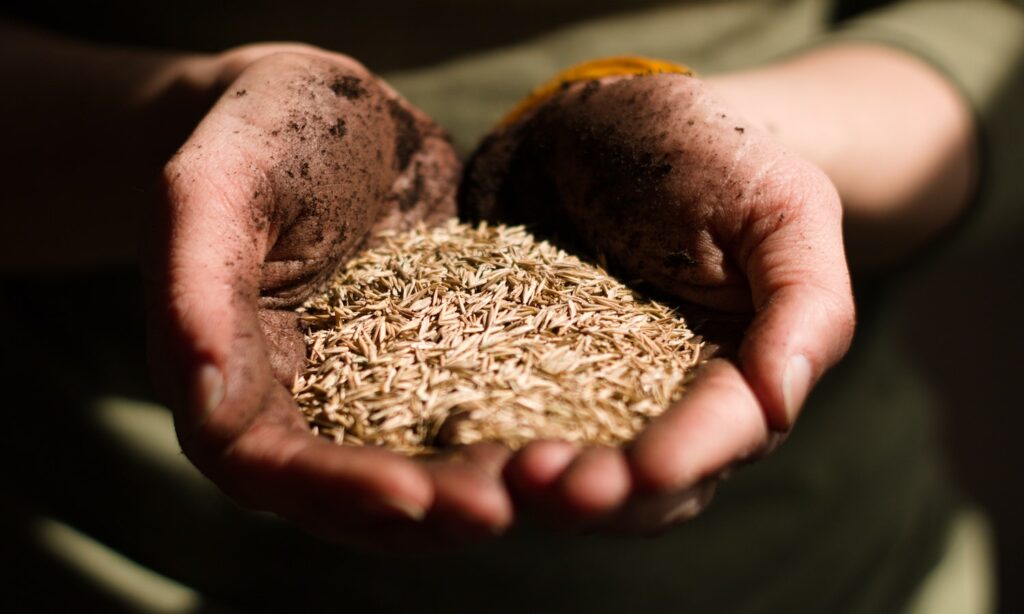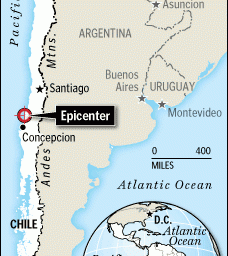Food Fight
A kerfuffle is brewing over the way the United States fights hunger in the global south.

NPR’s Dan Charles explains “Why there’s a storm brewing about global food aid from the U.S.” Since I had hitherto been unaware of said storm, I was curious.
Workers for Catholic Relief Services in Haiti got a stomach-turning surprise when they swung open the doors of some 20-foot-long shipping containers. Insects had infested thousands of bags of food. None of the sorghum or milled corn and soybeans, donated by the U.S. government, was fit for human consumption.
“I may have cried,” says Beth Carroll, the CRS representative who’s responsible for managing the Haiti food aid program. In all, she says, about 310 metric tons of food was lost in this 2022 incident.
The culprit seemed obvious. Because of ongoing chaos in Haiti, those containers had been sitting in the country’s port for weeks, increasing the risk of spoilage.
So, obviously, the spoilage of 310 metric tons of food aimed at the malnourished is sad. But this seems to be about logistics and handling, not the aid itself.
But Lora Iannotti, a nutrition and public health researcher at the Washington University in St. Louis, saw a deeper cause. Iannotti, who has worked in Haiti for decades, says the episode illustrates persistent problems with U.S. food aid. “It’s this facade of doing good,” she says, while also serving a less altruistic goal: Putting cash into the pockets of U.S. farmers by buying their grain and shipping it abroad.
The bastards! Why, how dare they pay the people who grow food for said food before transporting it for free and then giving it away to the poor?
Organizations in Haiti had previously questioned the wisdom of shipping U.S.-grown food there. They said the country had limited capacity to store imported grain, and feared the imports would actually discourage local food production. They’d proposed using locally grown food instead, but this isn’t allowed under the rules that govern U.S. food aid for “non-emergency” situations, such as in Haiti.
Well, okay. This is perhaps on par with food banks being better off with cash donations than random cans of lima beans that are in someone’s pantry that have to be sorted and warehoused. On the other hand, if there’s already plenty of locally-grown food, there’s likely not much need for U.S. assistance.
In addition, Iannotti says, the U.S. often sends commodities that American farmers want to sell, not foods that Haitians need most. Cornmeal and sorghum, for instance, hardly constitute a healthy diet. The infested bags of grain sent a message, she says: “We don’t really care if people are food secure in Haiti.”
So, first of all, go fuck yourself, Lora. We didn’t send infested bags of grain; they rotted from incompetent storage and distribution. And it turns out that a lot of Americans eat cornbread. Often with sorghum. It certainly beats the hell out of starving to death.
That said, yes, there’s a mixed purpose to the aid. It helps out American farmers, keeping farmland available for crop use, while also intending to help out the needy in the less developed world. That may be inefficient but hardly seems like something to be outraged over.
Those criticisms lie at the heart of a fresh debate on Capitol Hill over the rules governing America’s international food aid programs, which spent roughly $6 billion last year. Congress is about to rewrite some of those rules, as it does every five years when renewing a law called the Farm Bill. It’s reviving tensions between international development organizations and U.S. agricultural groups over whether that aid should be purchased from American farmers and shipped abroad.
I am, alas, skeptical of Congress’ ability to do much of anything useful these days.
Regardless, the Haiti example is rather unrepresentative:
Over the past two decades, development experts have persuaded Congress to allow food to be delivered in new, more flexible, ways. The U.S. Agency for International Development has begun buying food in foreign markets, close to where it is needed. It also distributes aid in the form of cash and vouchers, which people can use to buy food in local markets.
These “market-based” pathways can deliver food more quickly and often more cheaply. About 60% of U.S. international food aid is now handled this way. Yet “non-emergency” aid, such as in Haiti, still has to be delivered in the form of commodities that are grown by American farmers. Much of it, by law, also has to be shipped on vessels that are registered in the U.S. and owned by U.S. companies. There’s a limited supply of such ships, and a USAID official told Congress last year that this adds about 25% to the cost of shipping.
The Biden Administration, supported by some aid organizations, is now asking Congress to drop some of these restrictions on non-emergency aid.
American farm groups and shipping companies, however, are fighting back, mounting a campaign to “put the food back in food aid,” as one of their representatives put it during a meeting at USAID last summer. They are focusing on one major program, called Food for Peace, which is part of the Farm Bill. “Food for Peace has been successful, historically, because it supports and involves U.S. farmers, and has had tremendous political support,” says Peter Laudeman, director of trade policy for U.S. Wheat Associates, which represents wheat farmers. “We think this program can and should be working very, very well for U.S. farmers, and here’s the way to do that.”
That are politics are rife with politics should not be overly surprising. Again, we have overlapping goals here that hinder efficiency. The American taxpayer naturally wants to support American enterprise when possible. There are solid regulatory reasons for wanting to use American-flagged vessels. But, yes, local sourcing is often cheaper and more efficient. (Even the Defense Department is turning to it more and more in recent years.)
Dozens of groups, including the American Farm Bureau Federation and the National Association of Wheat Growers, are backing a new bill in Congress called the American Farmers Feed the World Act. The proposal would prevent Food for Peace from using any of its roughly $2 billion budget to buy food abroad or distribute cash and vouchers. The bill also would shift control of some parts of Food for Peace from USAID to the U.S. Department of Agriculture.
The law would not directly affect a separate, larger, program that USAID currently uses to deliver most of the food aid that’s purchased abroad, or distributed in the form of cash or vouchers. But Laudeman also has his eye on that program, called the Emergency Food Security Program. “We see that program buying from major global exporters that compete with U.S. farmers. That’s been very, very frustrating to our membership,” he says.
Again, this strikes me as normal politics. It’s one thing for aid programs to buy from local farmers when possible. That helps the local population twice and almost certainly is a more efficient way of doing good. It’s quite another to use U.S. tax dollars to buy from foreign conglomerates competing against American businesses.
The proposal takes aim at a growing category of Food for Peace spending called Section 202(e). It pays for management of the program but has expanded to include nutrition education. Some of it, in Haiti, allows people who receive Food for Peace commodities to buy more nutritious fresh foods as well. “Their objective is to use local ingredients, buying from farmers locally, which is super cool in principle, right?” says Iannotti.
I mean . . . maybe? I’m skeptical that folks in Haiti are any more unaware of basic nutrition facts than the average American. And fresh foods, while superior in theory, have a notoriously short shelf life — especially in a tropical climate.
The new bill would cut this spending drastically, limiting Section 202(e) spending to 10% of the Food for Peace budget, instead of 20%. The bill is seen as a legislative gambit in negotiations over the next Farm Bill, which could include similar language when it’s renewed, presumably sometime this year.
In a statement to NPR, USAID said that these proposed provisions would “severely limit emergency programs” and reduce the agency’s ability to make sure that aid actually reaches the most vulnerable. But in a nod to the political influence of U.S. farm groups, the agency also said that it intends to “keep U.S. commodities at the center of these programs.”
To the extent Congress is functional at all these days, it may be that the intersection of agriculture policy and development is relatively more so than those more prone to grandstanding and demagoguery. But USAID is an unusual creature in its own right, operating with the dual purposes of foreign aid and development assistance, both with humanitarian aims and with hopes of advancing American soft power.






I get your reaction, but it is more complicated than it appears. American wheat and other produce is shipped to developing countries not just when there is a crisis, but on a regular basis. It is “free” in the sense that it arrives in-country at no cost. But then it is somehow transferred to distribution networks and it is no longer free. By the time your average Joe (or Kofi) is buying a small loaf in the lorry park for his lunch, they are paying for it. But since the production cost was zero, at least from the developing country’s distribution network’s POV, it can be sold cheaper than locally grown stuff. And this is available year round, year after year, at least until the global price of grain goes up because of drought or war. So, rather than “teaching a man to fish” the effect of our aid is to put the already existing fisherman out of business.
In fact, the “teaching a man to fish” method of international development is actually against US law when it comes to farm aid, as the article states: “They’d proposed using locally grown food instead, but this isn’t allowed under the rules that govern U.S. food aid for “non-emergency” situations, such as in Haiti.”
We in the US like to think of ourselves as uniquely generous, but it isn’t true. We have a relatively small amount of international aid. Once you remove aid for Ukraine and Israel and for countries such as Egypt and Jordan who we support to benefit Israel, and all military and other aid to countries where we are conducting or supporting military actions (Yemen, Afghanistan, Somalia, etc) and food aid for non-emergency situations (which mostly is a way to subsidize our farmers without saying the word “subsidize”), there is really not that much left.
Bottom line is that most (but not all) food aid that we deliver is not for emergency situations, is predominantly funded because it subsidizes our farmers, and undercuts local producers of indigenous grains.
Food aid in the form of cash and vouchers is easier to steal (or tax by NGOs). See Clinton Foundation and Haiti
But the unmentioned result of not buying US production is the loss of that production and subsequent higher prices globally as the “local” purchases mean less on the market where that used to be sold. Why would that production in the US now go offline? Because it obviously isn’t free market profitable if it is being supported by government purchase now.
Fi0s5, c0an you please drop the arch Academic “Global South”, it’s pa pathetically bankrupt Left academic term that lumps utterly different countries, with about as much success in utility and clarity as the tiers mondiste Non aligned mouvement.
The countries concerned by this are Lower Income countries (World Bank category) and sometimes LMIC
There’s certainly some serious market distortion concerns, although at same time no magic wand to give result where Haitian farming in combo with security collapse can feed the urban agglomération of Port au Prince ( which I have actually spent quite some time in evaluating a potential investment but was unable to go forward for multiple reasons resolved down to worst unreformed business enviro this side of neo colonial 1831 (the date of their corporate law)). It remains a mess, and really badly needs to be completely replaced (any number of Francophone African models as like OHADA would be a huge stride forward.
There’s not a necessary contradiction between hlprovision of grains (free or subsidised) with a recognition that frtiuts and vegetable growing would be highly desirous, and the spoilage issue is reasonably addressable from prefabricated “stations de conditionnement” for cooling and storage (built for purpose, ot containers reporposed, staggeringlyenegy inefficient) runnable off of solar diesel or solar biogas units to alleviate grid and indeed diesel access issues. Inspira Garms of Kenya is example.
USAID can and does support domestic (target country) farm production, so the idea thats forbidden is non factual although they are trapped in the social justice Left mentality of only focusing on the impoverished marginal grower, who frankly nowhere in history is the river or backbone of significant food production as their plots are simply not scaleable. But perish the thought of looking at the hisorical econometrics from 19th c on, social justice sloganeering and virtue signalling trumps pragmatism and excludes middle sized farmers….
Market based if risk subsidised financing to assets like conditioning stations and seeds with support in distribution development is quite feasible – difficult but feasible. Ra0ther better than donations and dependent grants.
It is also worth observing that due to scale, at market price Ukrainian, Russian, Canadian and USA grains already beat local, as regardless lical production can not meet demand for multiple reason, even in excellent years (see Egypt, Tunisia).
@MarkedMan: donated grains take over by grey and mafia markets is what you get in state collapse situations. Piously posturing on that as a “critique” is empty virtue signalling as the only choice to avoid in scale situations is armed intervention and then you’d flip to hand wringing about neo colonialism.
@Lounsbury: God help me, I read your comments. You are woefully ignorant about this whole issue and would be better off if you tried to learn something instead of trying to mash your (supposed) area of expertise into the situation.
@markedman:
Ayup! That’s why I skip over them now. That and the exasperation over other people’s “empty virtue signaling.”
@just nutha: Aside from the dickishness and arrogance in his posts, they are just of such poor quality. He makes no attempt to understand what other people are saying and tries to mush his preconceived notions onto every situation, whether he knows anything about it or not. Whenever you try to distill actual content from that gushing river of bile and asides, there is very little there there, and what remains is quite often either so obvious as to be trite or just plain wrong.
In this case I saw that he didn’t understand what was being said by James or by me (he may have understood the other comment – I didn’t read that one), and so didn’t address any of it in a worthwhile way. I’ve always thought it quite possible he has no qualifications whatsoever and is just some angry 45 year old secondary school drop out living in his parents basements attempting to regurgitate stuff he gleans from “The Economist”. At least in this case, it’s pretty obvious that he is completely unaware of two of the primary and decades old issues in development (how different types of aid can cause local market distortions; how vested donor country interests can overwhelm the actual needs of a developing country) and his handwaving dismissals and assertions that it is all easily solved is just laughable.
Considering how lengthy and rambling the posts are, and so full of inaccuracies, I would think it the work of a generative AI, but I’m pretty sure his posts here predate the point at which those systems reached this level.
US food aid is, like ethanol, another sop to American small grain farmers, wheat corn etc, who at the end of the trump admin (I don’t have updated data), received 40% of their income from government subsidies.
We might feel good about that if it were in support of smaller, family farms, but most of the money is sucked up in large corporate operations, some owned by Fortune 500 companies. A friend, who has about 1500 acres of corn in southern Minnesota, will tell anyone who will listen that small farmers would be far better off in a market system.
Just for the hell of it:
Paragraph that starts “Fi0s5, c0an you please drop …”: Just dickishness, with poor spelling
Paragraph that starts “The countries concerned…”: Pedantry that contributes nothing
Paragraph that starts “There’s certainly some serious market distortion concerns…”: Opening phrase repeats the obvious and then the rest is a dick-waving aside (even if one believes it)
Paragraph that starts “There’s not a necessary contradiction…”: Not sure there is any actual content in this paragraph, and it seems to end by essentially saying that if Haiti were Kenya then it wouldn’t be Haiti. Not much of an insight
Paragraph that starts “USAID can and does support domestic…”: By stating a non-sequitur he demonstrates that he hasn’t paid attention to the original comment (that the specific aid in question is aid-in-kind from American producers, by Congressional mandate), and then conflates it with other programs that are not being discussed and are a tiny, tiny fraction of the aid budget. From there it just descends into hobby horse babble.
Paragraph that starts “Market based if risk subsidized financing”: I think (hard to tell) it is actually agreeing with the idea that developing indigenous markets (teaching a man to fish) is better. Trite, and something pretty much everyone agrees with, but it doesn’t address the issue here, which is that very little money and effort is put into that particular type of aid because the vast majority of food aid is primarily a subsidy of farmers and actually works against what (I think) he and everyone else will acknowledge is preferable. So, as usual, in his haste to put fingers to what is obviously his phone keyboard (I assume he has autocorrect turned off – HOW DARE A MACHINE CORRECT HIM!) and vomit his every thought, tangent and insult out into the world, he demonstrates that he hasn’t actually thought about what others have said.
Paragraph that starts “It is also worth observing that due to scale”: He regales us with this gem: Countries with well developed agricultural sectors are more efficient than countries without.
Paragraph that starts “@MarkedMan: donated grains take over by grey and mafia markets”: Here he puts forth yet another piece of profound wisdom: one of the reasons developmental aid is so difficult is that local governments are ineffective, corrupt or both. Wait, I’ll send that off to the heads of development agencies everywhere, because it’s important they are made aware of it as quickly as possible.
In the end, a lot of hot air, insults and non-sequiturs, a dick-waving attempt to project authority, and a couple of trite and pretty much universally accepted banalities. This is why I normally skip over anything that contains his name and regret not having done so today.
@MarkedMan: I wouldn’t be inclined to think he’s using AI tech. The samples I’ve read have tended to be very tightly scaffolded–or scripted if one prefers*–and the language tends to be neutral toward the audience. AI and simply more courteous in tone than he is.
*See, for example, the sample Mimai provided yesterday (? the day before?) from, I think, the standup post. The AI was scrupulously careful to make sure that the reader knew what question was being answered by the response. Lounsbury is hardly ever that lucid of expression.
And I won’t even comment on the tonal comparison. I’ve no language with which to do it.
While wasting 20 minutes of my life running down Lounsbury’s swill, I realized I might have given a wrong impression when I said that the food aid, specifically American wheat, doesn’t remain no-cost by the time it reaches an individual. I wasn’t putting that out as a bad thing, but rather just sought to correct the impression most people have of food aid as consisting of bags of grain given to starving individuals. That only applies in the minority of emergency cases. I actually think it is a good thing that a real market and supply chain develops around this food aid and that people are employed. When someone buys a small white wheat loaf at the lorry park and brings it around to the rice lady to split in half and fill from her pot, there are two people with their own businesses, who buy from distributors that have their own businesses, and so forth. It helps create a viable and self sustaining economy.
But it’s also true that many more jobs and businesses would be created by encouraging local agricultural development. In non-emergency situations, flooding the market with shiploads of American wheat has the beneficial effect of lowering the cost of food for the average person, but the disadvantage of impeding the development of a local agricultural sector. (Of course in emergencies such as drought and famine, getting calories in by pretty much any method possible is of top importance.) Trying to figure out how to promote development rather than simply providing subsidized food is a devilishly difficult maze to negotiate because of donor country special interests, local ineptitude and corruption, aid agency sinecures, and a hundred other things. Since I started paying attention to this decades ago I’ve realized the burnout rate of sincere and smart people is very, very high, and it is not unusual for people, even at very high levels, to decide it is simply impossible.